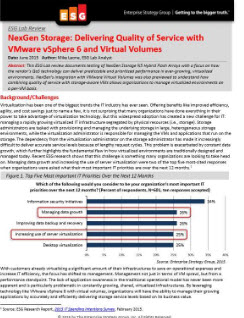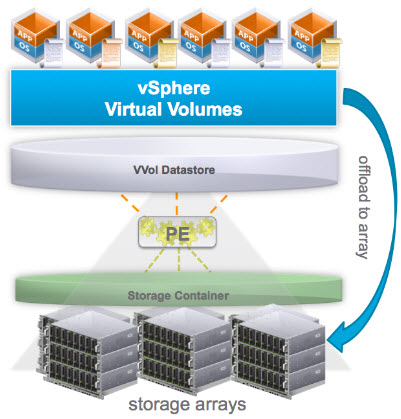There is a new PDF which might be your interest if you're into VMware VVols. This offer is from Pivot3. You can check it out here – Pivot3: Delivering Quality of Service with VMware vSphere 6 and Virtual Volumes.
In effect, VVOL works by having supported storage arrays publish the various services it offers, such as replication, RAID capabilities etc. via VASA (VMware APIs for Storage Awareness) APIs. These can be seen by the VMware management tools to allow your VM team to describe the needs of any individual VM and allow the software to allocate it to any storage array that offers those characteristics and has the required space available.
To use VVol storage, you will need vSphere 6.0 or higher and certified array vendor Virtual Volumes software (VASA Provider).
With Pivot3's recent acquisition of NexGen Storage, the company is uniquely addressing software-defined data center challenges with a broad portfolio that includes HCI, high-performance storage and quality of service. In this ESG Lab review, Pivot3's N5 Hybrid Flash Array was tested with a focus on how the vendor's QoS technology can deliver predictable and prioritized performance in ever-growing, virtualized environments. NexGen's integration with VMware Virtual Volumes was also previewed to understand how combining quality of service with storage-aware VMs allows organizations to manage virtualized environments on a per-VM basis.
 Learn how you can:
Learn how you can:
- Eliminate degradation in response times and IOPS by setting QoS policies
- Increase VM density by roughly 25% with QoS
- Easily map QoS policy levels to VM storage policies with VVOL
Get the PDF here: Pivot3: Delivering Quality of Service with VMware vSphere 6 and Virtual Volumes.
Basic knowledge about VMware VVols
What is a Protocol Endpoint (PE) – Protocol endpoints are the access points from the hosts to the storage systems, which are created by storage administrators. All path and policies are administered by protocol endpoints. Protocol Endpoints are compliant with both, iSCSI and NFS. They are intended to replace the concept of LUNs and mount points.
What is a storage container and how does it relate to a VVol Datastore – A storage container is a logical abstraction on to which Virtual Volumes are mapped and stored. Storage containers are setup at the array level and associated with array capabilities. vSphere will map storage containers to VVol Datastores and provide applicable datastore level functionality. The VVol Datastore is a key element and it allows the vSphere Admin to provision VMs without depending on the Storage Admin. Moreover, the VVol Datastore provides logical abstraction for managing a very large number of Virtual Volumes. This abstraction can be used for better managing multi-tenancy, various departments within a single organization, etc.
 How does a PE function – A PE represents the IO access point for a Virtual Volume. When a Virtual Volume is created, it is not immediately accessible for IO. To Access Virtual Volumes, vSphere needs to issue a “Bind” operation to a VASA Provider (VP), which creates IO access point for a Virtual Volume on a PE chosen by a VP. A single PE can be the IO access point for multiple Virtual Volumes. “Unbind” Operation will remove this IO access point for a given Virtual Volume.
How does a PE function – A PE represents the IO access point for a Virtual Volume. When a Virtual Volume is created, it is not immediately accessible for IO. To Access Virtual Volumes, vSphere needs to issue a “Bind” operation to a VASA Provider (VP), which creates IO access point for a Virtual Volume on a PE chosen by a VP. A single PE can be the IO access point for multiple Virtual Volumes. “Unbind” Operation will remove this IO access point for a given Virtual Volume.
What is the association of the PE to storage array – PEs are associated with arrays. One PE is associated with one array only. An array can be associated with multiple PEs. For block arrays, PEs will be a special LUN. ESX can identify these special LUNs and make sure that visible list of PEs is reported to the VP. For NFS arrays, PEs are regular mount points.
What is the association of a PE to storage containers – PEs are managed per array. vSphere will assume that all PEs reported for an array are associated with all containers on that array. E.g: If an array has 2 containers and 3 PEs then ESX will assume that Virtual Volumes on both containers can be bound on all 3 PEs. But internally VPs and storage arrays can have specific logic to map Virtual Volumes and storage containers to PE.
What is the association of a PE to Hosts – PEs are like LUNs or mount points. They can be mounted or discovered by multiple hosts.
Get the PDF here: Pivot3: Delivering Quality of Service with VMware vSphere 6 and Virtual Volumes.
